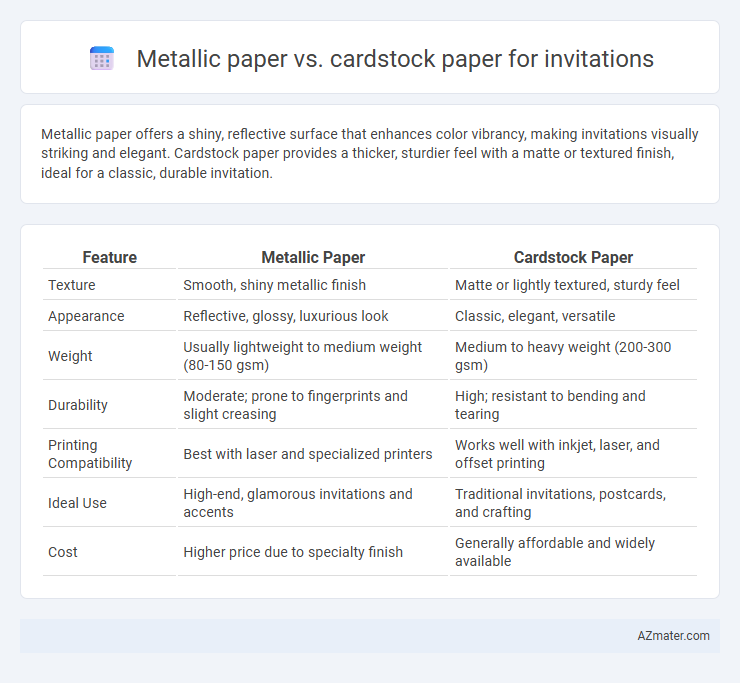Metallic paper offers a shiny, reflective surface that enhances color vibrancy, making invitations visually striking and elegant. Cardstock paper provides a thicker, sturdier feel with a matte or textured finish, ideal for a classic, durable invitation.
Table of Comparison
| Feature | Metallic Paper | Cardstock Paper |
|---|---|---|
| Texture | Smooth, shiny metallic finish | Matte or lightly textured, sturdy feel |
| Appearance | Reflective, glossy, luxurious look | Classic, elegant, versatile |
| Weight | Usually lightweight to medium weight (80-150 gsm) | Medium to heavy weight (200-300 gsm) |
| Durability | Moderate; prone to fingerprints and slight creasing | High; resistant to bending and tearing |
| Printing Compatibility | Best with laser and specialized printers | Works well with inkjet, laser, and offset printing |
| Ideal Use | High-end, glamorous invitations and accents | Traditional invitations, postcards, and crafting |
| Cost | Higher price due to specialty finish | Generally affordable and widely available |
Overview of Metallic Paper and Cardstock Paper
Metallic paper features a reflective, shiny surface that enhances visual appeal with a luxurious, high-gloss finish, making it ideal for upscale invitations. Cardstock paper is thicker and more durable, offering a sturdy and matte or gloss finish that supports high-quality printing and conveys a classic, professional look. Choosing between metallic and cardstock paper depends on the desired aesthetic and texture, with metallic paper emphasizing elegance and cardstock paper ensuring durability.
Key Differences Between Metallic and Cardstock Paper
Metallic paper offers a shiny, reflective surface that enhances invitation designs with a luxurious, eye-catching finish, while cardstock paper provides a thicker, more rigid base known for its durability and classic texture. Metallic paper tends to be thinner and less sturdy compared to the heavyweight cardstock, which ensures invitations maintain structural integrity during handling and mailing. Choosing metallic paper emphasizes visual appeal and uniqueness, whereas cardstock prioritizes sturdiness and traditional craftsmanship for high-quality invitations.
Visual Appeal: Shine vs. Matte Finish
Metallic paper offers a striking shine that enhances invitation designs with a reflective, luxurious appearance, making colors and details pop vibrantly. In contrast, cardstock paper provides a matte finish that delivers a classic, understated elegance with a smooth texture and minimal glare. Choosing between metallic and cardstock paper depends on whether the invitation aims to emphasize dazzling visual impact or a subtle, sophisticated look.
Texture and Feel: Touching Experience
Metallic paper offers a smooth, glossy texture with a reflective sheen that creates a luxurious, high-end feel ideal for elegant invitations. Cardstock paper provides a thicker, matte or slightly textured surface, giving a sturdy and tactile experience that conveys durability and a handcrafted touch. The choice between metallic paper and cardstock significantly impacts the invitation's tactile impression, with metallic paper emphasizing sleek sophistication and cardstock emphasizing substantive quality.
Printing Compatibility and Results
Metallic paper offers a reflective, shiny surface that enhances color vibrancy and adds a luxurious finish, making it ideal for inkjet and laser printing with vivid, eye-catching results. Cardstock paper provides a thicker, sturdier texture that supports various printing methods, including offset, screen, and digital printing, yielding crisp, professional-quality invitations with excellent durability. Choosing between metallic paper and cardstock depends on the desired visual impact and the compatibility with specific printers to ensure optimal invitation presentation.
Durability and Paper Weight Comparison
Metallic paper offers a distinctive sheen and is generally heavier, ranging from 80 to 130 lb cover weight, providing moderate durability suitable for elegant invitations. Cardstock, typically heavier and thicker with weights between 65 and 110 lb, excels in durability due to its dense fiber composition, ensuring invitations resist bending and wear over time. For long-lasting invitations, cardstock's superior thickness and sturdiness often outperform metallic paper despite the latter's visual appeal.
Cost Considerations: Metallic vs Cardstock
Metallic paper typically costs more than cardstock due to its specialized coating and reflective finish, which enhances visual appeal but increases production expenses. Cardstock offers a more budget-friendly option with thicker, durable quality ideal for invitations without the premium pricing of metallic options. Choosing between metallic and cardstock depends on balancing the desired aesthetic impact with cost constraints and event formality.
Ideal Occasions for Each Paper Type
Metallic paper is ideal for upscale events such as weddings, gala dinners, and milestone celebrations due to its shimmering finish that adds elegance and sophistication to invitations. Cardstock paper suits more casual or versatile occasions like birthday parties, baby showers, and corporate events, offering durability and a classic matte or textured look. For a luxurious appearance that stands out, metallic paper enhances invitations, while cardstock provides flexibility and practicality for everyday events.
Personalization and Customization Options
Metallic paper offers a unique, reflective surface that enhances foil stamping, embossing, and vibrant color printing, making it ideal for invitations with intricate designs and shimmer effects. Cardstock paper provides a thicker, more durable base, supporting diverse textures and finishes such as matte, gloss, or recycled options, allowing for versatile customization through handwritten notes, die cuts, and layered elements. Both papers support personalized printing methods, but metallic paper excels in visual impact, while cardstock offers greater flexibility in tactile and structural customization.
Environmental Impact and Sustainability
Metallic paper often contains synthetic coatings and non-recyclable materials that increase its environmental footprint compared to cardstock paper, which is typically made from natural fibers and is more easily recyclable. Cardstock paper's biodegradability and compatibility with eco-friendly inks minimize waste and reduce chemical pollution. Choosing cardstock paper for invitations supports sustainability efforts by promoting renewable resources and lowering overall environmental impact.

Infographic: Metallic paper vs Cardstock paper for Invitation
 azmater.com
azmater.com